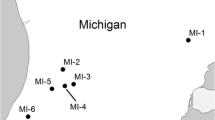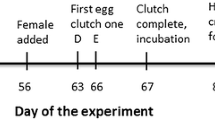Abstract
Bird song is considered to have evolved via sexual selection and should as such honestly signal aspects of the quality of its bearer. To ensure honesty, the immunocompetence handicap hypothesis proposed a dual role of testosterone, having positive effects on sexual signalling but suppressive effects on immune function. However, recent studies showed that it is rather an immune activation that suppresses the androgen production. This reversed chain of causation may significantly alter the pathways, which translate the effects of parasites and pathogens into changes in the expression of male sexual traits. We infested male canaries with Ixodes ricinus tick nymphs to investigate the causal relationships between (ecto-)parasites, testosterone and sexual signalling, here singing behaviour. We focused on flexible song traits, which may quickly reflect changes in the infestation status, and tested whether these effects relate to changes in the plasma testosterone levels or health state. The experimental tick infestation altered the males’ song performance by reducing song consistency, a trait that had previously been identified to reflect male quality. The tick infestation lowered the plasma testosterone levels and had a negative effect on the health status in terms of a reduced hematocrit. Our pathway analysis then revealed that it is the parasite-induced reduction of the plasma testosterone levels but not of the health state that caused the changes in song consistency. Thus, our study supports the view that it is the effect of parasites and immune activation on plasma testosterone levels that generates the trade-off between immunocompetence and sexual signalling.


Similar content being viewed by others
References
Alatalo RV, Glynn C, Lundberg A (1990) Singing rate and female attraction in the pied flycatcher: an experiment. Anim Behav 39:601–603
Andersson M (1994) Sexual selection. Princeton University Press, Princeton
Arbuckle JL (2010) Amos 19 User's Guide. SPSS, Chicago
Ballentine B, Hyman J, Nowicki S (2004) Vocal performance influences female response to male bird song: an experimental test. Behav Ecol 15:163–168
Blas J, Pérez-Rodríguez L, Bortolotti GR, Viñuela J, Marchant TA (2006) Testosterone increases bioavailability of carotenoids: insights into the honesty of sexual signaling. Proc Natl Acad Sci U S A 103:18633–18637
Boonekamp JJ, Ros AHF, Verhulst S (2008) Immune activation suppresses plasma testosterone level: a meta-analysis. Biol Lett 4:741–744
Botero CA, Rossman RJ, Caro LM, Stenzler LM, Lovette IJ, de Kort SR, Vehrencamp SL (2009) Syllable type consistency is related to age, social status and reproductive success in the tropical mockingbird. Anim Behav 77:701–706
Boyer N, Reale D, Marmet J, Pisanu B, Chapuis J (2010) Personality, space use and tick load in an introduced population of Siberian chipmunks Tamias sibiricus. J Anim Ecol 79:538–547
Brossard M, Wikel SK (2004) Tick immunobiology. Parasitology 129:S161–S176
Buchanan KL, Catchpole CK, Lewis JW, Lodge A (1999) Song as an indicator of parasitism in the sedge warbler. Anim Behav 57:307–314
Byers BE (2007) Extrapair paternity in chestnut-sided warblers is correlated with consistent vocal performance. Behav Ecol 18:130–136
Casagrande S, Groothuis TGG (2011) The interplay between gonadal steroids and immune defence in affecting a carotenoid-dependent trait. Behav Ecol Sociobiol 65:2007–2019
Catchpole CK, Slater PJB (2008) Bird song—themes and variations. Cambridge University Press, Cambridge
Champagne DE, Valenzuela JG (1996) Pharmacology of haematophagous arthropod saliva. In: Wikel SK (ed) The immunology of host-ectoparasitic arthropod relationships. CAB International, Wallingford, pp 85–106
Clark CW, Marler P, Beeman K (1987) Quantitative-analysis of animal vocal phonology—an application to swamp sparrow song. Ethology 76:101–115
Cortopassi KA, Bradbury JW (2000) The comparison of harmonically rich sounds using spectrographic cross-correlation and principal coordinates analysis. Bioacoustics 11:89–127
Cox RM, John-Alder HB (2007) Increased mite parasitism as a cost of testosterone in male striped plateau lizards Sceloporus virgatus. Funct Ecol 21:327–334
Cox RM, Skelly SL, John-Alder HB (2005) Testosterone inhibits growth in juvenile male eastern fence lizards (Sceloporus undulatus): implications for energy allocation and sexual size dimorphism. Physiol Biochem Zool 78:531–545
De Vaney JA, Elissalde MH, Steel EG, Hogan BF, Delvarpetersen H (1977) Effect of northern fowl mite (Ornithonyssus sylviarum) on white leghorn roosters. Poult Sci 56:1585–1590
Draganoiu TI, Nagle L, Kreutzer M (2002) Directional female preference for an exaggerated male trait in canary (Serinus canaria) song. Proc R Soc Lond B 269:2525–2531
Dreiss AN, Navarro C, de Lope F, Møller AP (2008) Effects of an immune challenge on multiple components of song display in Barn swallows Hirundo rustica: implications for sexual selection. Ethology 114:955–964
Duffy DL, Ball GF (2002) Song predicts immunocompetence in male European starlings (Sturnus vulgaris). Proc R Soc Lond B 269:847–852
Faivre B, Grégoire A, Préault M, Cézilly F, Sorci G (2003) Immune activation rapidly mirrored in a secondary sexual trait. Science 300:103
Folstad I, Karter AJ (1992) Parasites, bright males, and the immunocompetence handicap. Am Nat 139:603–622
Galeotti P, Saino N, Sacchi R, Møller AP (1997) Song correlates with social context, testosterone and body condition in male barn swallows. Anim Behav 53:687–700
Garamszegi LZ (2005) Bird song and parasites. Behav Ecol Sociobiol 59:167–180
Garamszegi LZ, Møller AP, Torok J, Michl G, Peczely P, Richard M (2004) Immune challenge mediates vocal communication in a passerine bird: an experiment. Behav Ecol 15:148–157
Gil D, Gahr M (2002) The honesty of bird song: multiple constraints for multiple traits. Trends Ecol Evol 3:133–141
Gilman S, Blumstein DT, Foufopoulos J (2007) The effect of hemasporidian infections on white-crowned sparrow singing behaviour. Ethology 113:437–445
Goerlich VC, Dijkstra C, Schaafsma SM, Groothuis TGG (2009) Testosterone has a long-term effect on primary sex ratio of first eggs in pigeons—in search of a mechanism. Gen Comp Endocrinol 163:184–192
Goodman JL, Dennis DT, Sonenshine DE (2005) Tick borne diseases of humans. ASM Press, Washington
Grafen A (1990) Biological signals as handicaps. J Theor Biol 144:517–546
Greiner S, Stefanski V, Dehnhard M, Voigt CC (2010) Plasma testosterone levels decrease after activation of skin immune system in a free-ranging mammal. Gen Comp Endocrinol 168:466–473
Hamilton WD, Zuk M (1982) Heritable true fitness and bright birds: a role for parasites. Science 218:384–387
Heylen DJA, Matthysen E (2008) Effect of tick parasitism on the health status of a passerine bird. Funct Ecol 22:1099–1107
Heylen D, Madder M, Matthysen E (2010) Lack of resistance against the tick Ixodes ricinus in two related passerine bird species. Int J Parasitol 40:183–191
Hughes VL, Randolph SE (2001) Testosterone increases the transmission potential of tick-borne parasites. Parasitology 123:365–371
John-Alder HB, Cox RM, Haenel GJ, Smith LC (2009) Hormones, performance, and fitness: natural history and endocrine experiments on a lizard (Sceloporus undulatus). Integr Comp Biol 49:393–407
Klukowski M, Nelson CE (1998) The challenge hypothesis and seasonal changes in aggression and steroids in male northern fence lizards (Sceloporus undulatus hyacinthinus). Horm Behav 33:197–204
Klukowski M, Nelson CE (2001) Ectoparasite intensities in freeranging northern fence lizards, Sceloporus undulatus hyacinthinus: effects of testosterone and sex. Behav Ecol Sociobiol 49:289–295
Leboucher G, Vallet E, Nagle L, Béguin N, Bovet D, Hallé F, Draganoiu T, Amy M, Kreutzer M (2012) Studying female reproductive activities in relation to male song: the domestic canary as a model. Adv Study Behav 44:182–223
Macnab V, Scott AP, Katsiadaki I, Barber I (2011) Variation in the reproductive potential of Schistocephalus infected male sticklebacks is associated with 11-ketotestosterone titre. Horm Behav 60:371–379
McGraw KJ, Ardia DR (2003) Carotenoids, immunocompetence, and the information content of sexual colors: an experimental test. Am Nat 162:704–712
McGraw KJ, Correa SM, Adkins-Regan E (2006) Testosterone upregulates lipoprotein status to control sexual attractiveness in a colorful songbird. Behav Ecol Sociobiol 60:117–122
Milinski M (2001) Bill Hamilton, sexual selection, and parasites. Behav Ecol 12:264–266
Møller AP (1991) Parasite load reduces song output in a passerine bird. Anim Behav 41:723–730
Møller AP, Christie P, Lux E (1999) Parasitism, host immune function, and sexual selection. Q Rev Biol 74:3–20
Moore MC (1986) Elevated testosterone levels during non-breeding season territoriality in a fall-breeding lizard, Sceloporus jarrovi. J Comp Physiol A 158:159–163
Muehlenbein MP, Hirschtick JL, Bonner JZ, Swartz AM (2010) Toward quantifying the usage costs of human immunity: altered metabolic rates and hormone levels during acute immune activation in men. Am J Hum Biol 22:546–556
Müller W, Vergauwen J, Eens M (2010) Testing the developmental stress hypothesis in canaries: consequences of nutritional stress on adult song phenotype and mate attractiveness. Behav Ecol Sociobiol 64:1767–1777
Nottebohm F (2005) The neural basis of birdsong. PLoS Biol 3:759–761
Olsson M, Wapstra E, Madsen T, Silverin B (2000) Testosterone, ticks, and travels: a test of the immunocompetence-handicap hypothesis in free ranging male sand lizards. Proc R Soc Lond B 267:2339–2343
Podos J (1997) A performance constraint on the evolution of trilled vocalizations in a songbird family (Passeriformes: Emberizidae). Evolution 51:537–551
Podos J, Lahti DC, Moseley DL (2009) Vocal performance and sensorimotor learning in songbirds. Adv Study Behav 40:159–195
Potti J, Moreno J, Merino S, Frias O, Rodriguez R (1999) Environmental and genetic variation in the haematocrit of fledgling pied flycatchers Ficedula hypoleuca. Oecologia 120:1–8
Radesater TS, Jacobson S, Andbjer N, Bylin A, Nystrom K (1987) Song rate and pair formation in the willow warbler Phylloscopus trochilus. Anim Behav 35:1645–1651
Redpath SM, Appleby MB, Petty SJ (2000) Do male hoots betray parasite loads in tawny owls? J Avian Biol 31:457–462
Rivera-Gutierrez HF, Pinxten R, Eens M (2011) Songs differing in consistency elicit differential aggressive response in territorial birds. Biol Lett 7:339–342
Rivera-Gutierrez HF, Pinxten R, Eens M (2012) Tuning and fading voices in songbirds: age-dependent changes in two acoustic traits across the life span. Anim Behav 83:1279–1283
Roberts ML, Buchanan KL, Evans MR (2004) Testing the immunocompetence handicap hypothesis: a review of the evidence. Anim Behav 68:227–239
Ros AFH, Correia M, Wingfield JC, Oliveira RF (2009) Mounting an immune response correlates with decreased androgen levels in male peafowl, Pavo cristatus. J Ethol 27:209–214
Ros AFH, Oliveira RF, Dijkstra PD, Groothuis TGG (2012) Immune activation is inversely related to, but does not cause variation in androgen levels in a cichlid fish species. Fish Shellfish Immunol 33:130–133
Saino N, Møller AP, Bolzern AM (1995) Testosterone effects on the immune system and parasite infestations in the barn swallow (Hirundo rustica): an experimental test of the immunocompetence hypothesis. Behav Ecol 6:397–404
Saino N, Galeotti P, Sacchi R, Møller AP (1997) Song and immunological conditions in male barn swallows (Hirundo rustica). Behav Ecol 8:364–371
Sakata JT, Vehrencamp SL (2012) Integrating perspectives on vocal performance and consistency. J Exp Biol 215:201–209
Searcy WA, Andersson M (1986) Sexual selection and the evolution of song. Annu Rev Ecol Syst 17:507–533
Sinervo B, Miles DB, Frankino WA, Klukowski M, DeNardo DF (2000) Testosterone, endurance, and Darwinian fitness: natural and sexual selection on the physiological bases of alternative male behaviors in side-blotched lizards. Horm Behav 38:222–233
Vallet E, Kreutzer M (1995) Female canaries are sexually responsive to special song phrases. Anim Behav 49:1603–1610
Vallet E, Beme I, Kreutzer M (1998) Two-note syllables in canary songs elicit high levels of sexual display. Anim Behav 55:291–297
Weatherhead PJ, Metz KJ, Bennett GF, Irwin RE (1993) Parasite faunas, testosterone and secondary sexual traits in male red-winged blackbirds. Behav Ecol Sociobiol 33:13–23
Wingfield JC, Hahn TP (1994) Testosterone and territorial behaviour in sedentary and migratory sparrows. Anim Behav 47:77–89
Zahavi A (1975) Mate selection—a selection for a handicap. J Theor Biol 53:205–214
Acknowledgments
We thank Vivian Goerlich and Jonas Vergauwen for the hormone analyses, and Stefania Casagrande for constructive comments on the manuscript. WM and ME received funding support by FWO project G.0102.12 N and KP BOF UA 2008. DH was supported by an FWO post-doctoral fellowship.
Ethical standards
This experiment complies with the Flemish and Belgian law and was conducted with approval by the animal experimentation committee of the University of Antwerp (number 2008-26).
Author information
Authors and Affiliations
Corresponding author
Additional information
Communicated by H. Brumm
Rights and permissions
About this article
Cite this article
Müller, W., Heylen, D., Eens, M. et al. An experimental study on the causal relationships between (ecto-)parasites, testosterone and sexual signalling. Behav Ecol Sociobiol 67, 1791–1798 (2013). https://doi.org/10.1007/s00265-013-1586-6
Received:
Revised:
Accepted:
Published:
Issue Date:
DOI: https://doi.org/10.1007/s00265-013-1586-6




